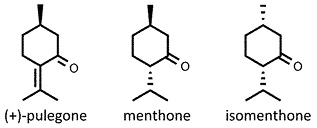 Mentha pulegium
Mentha pulegium
pennyroyal
Back to “Culinary herbs: pennyroyal (Mentha pulegium)”
Mentha pulegium L. (Lamiaceae); poleiment (Afrikaans); chun e bo he (Chinese); polei (Dutch); menthe pouliot, herbe aux puces (French); Flohkraut, Poleiminze (German); menta puleggia (Italian); penirooyaru minto (Japanese); menta poleo (Spanish); poleijmynta (Swedish); cây bac hà hăng (Vietnamese)
DESCRIPTION The leaves are very small, with minutely toothed margins and a characteristic sweet smell resembling that of peppermint.
THE PLANT A robust perennial herb with ground-hugging stems and clusters of tiny pale violet flowers. The leaves of Corsican mint (M. requienii) are much smaller, scarcely exceeding 6 mm (¼ in.) in length, with smooth margins.
ORIGIN Europe and western Asia. It has become invasive in parts of Australia and the United States.1 Corsican mint is western Mediterranean in origin and is naturalized in Britain.1
CULTIVATION Both species are easily propagated from cuttings or by division. They are hardy but will do best in moist, partly shady places. These plants are ideal along paths and stepping stones in the herb garden, because they rapidly form attractive groundcovers that emit a sweet, minty smell when bruised underfoot. They tend to become invasive in the garden and can be contained by using sunken containers, slate tiles or stones.
HARVESTING The leaves are simply picked when required. Pennyroyal oil (poisonous!) is distilled from flowering tops.
CULINARY USES Pennyroyal was an important culinary herb (and flavourant of wine and sailors’ drinking water)1 in ancient Rome and Greece, and during the Middle Ages. Today it is seldom used but can be sparingly combined with other herbs and spices to enrich the flavour of soups, stews, stuffings, vegetables and puddings. Corsican mint can also be used in small amounts in mint sauces (to complement lamb), as well as soups, salads, vegetable dishes, desserts, canned fruits and cold drinks. Both these mints are added to herbal teas and tisanes in small amounts.
FLAVOUR COMPOUNDS The main compound in pennyroyal is usually (+)-pulegone (about 80%)2 but it appears to be quite variable, depending on provenance and method of extraction and analysis. Portuguese oil, for example, had menthone, pulegone and neo-menthol as the main constituents3 while Turkish oil had isomenthone, pulegone, piperitenone and piperitone.4 Headspace analysis gave mostly isomenthone, with some pulegone and small amounts of menthol.4 The essential oil of M. requienii appears to be quite similar, yielding pulegone (78%) and isomenthone (18%), with small amounts of limonene, isopulegone and menthone.5

NOTES Pennyroyal has been used in traditional medicine as folk remedy and abortifacient,1 as well as a repellent for insects and snakes. The oil is used in soaps and hygiene products, as well as in aromatherapy but great care should be taken, as it is very poisonous. Pennyroyal should not be confused with American pennyroyal or American false pennyroyal (Hedeoma pulegioides, also of the family Lamiaceae), which produces an oil of similar composition (American pennyroyal oil).2
1. Mabberley, D.J. 2008. Mabberley’s plant-book (3rd ed.). Cambridge University Press, Cambridge.
2. Harborne, J.B., Baxter, H. 2001. Chemical dictionary of economic plants. Wiley, New York.
3. Teixeira B., Marques, A., Ramos, C. et al. 2012. European pennyroyal (Mentha pulegium) from Portugal: Chemical composition of essential oil and antioxidant and antimicrobial properties of extracts and essential oil. Industrial Crops and Products 36: 81–87.
4. Yasa, H., Onar, H.C., Yusufoglu, A.S. 2012. Chemical composition of the essential oil of Mentha pulegium L. from Bodrum, Turkey. Journal of Essential Oil Bearing Plants 15: 1040–1043.
5. Chessa, M., Sias, A., Piana, A., Mangano, G.S., Petretto, G.L., Masia, M.D., Tirillini, B., Pintore, G. 2012. Chemical composition and antibacterial activity of the essential oil from Mentha requienii Bentham. Natural Products Research 27: 93–99.